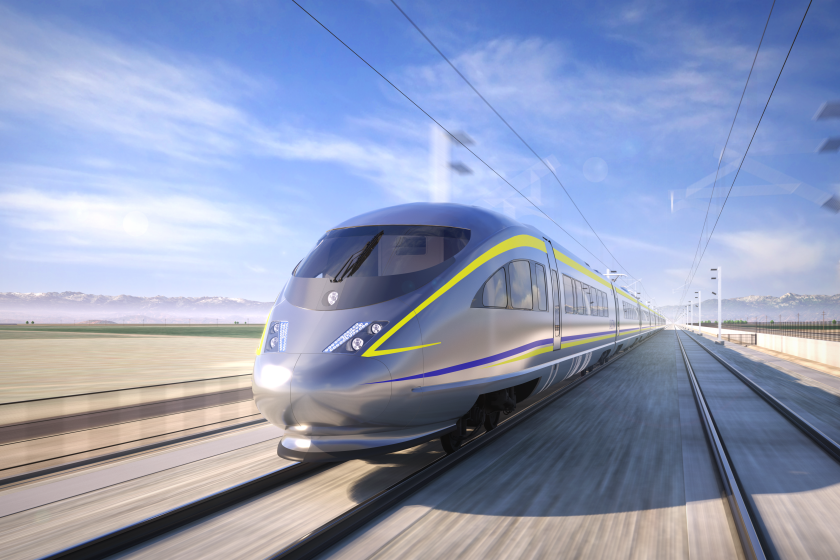Ferraro Outlines Plan for Light Rail System
- Share via
Los Angeles City Councilman John Ferraro, who in his bid for mayor has vowed “to build a realistic transportation system,” Wednesday outlined a proposed 50-mile light rail system that he contends should replace the financially beleaguered Metro Rail subway.
Ferraro, a persistent critic of the proposed $3.3-billion subway, suggested an alternative plan: two light rail lines--one running 26 miles from the San Fernando Valley to South Bay and the other extending 24 miles between Woodland Hills and downtown Los Angeles.
Both lines would use elevated tracks along the center strips of the San Diego, Ventura and Hollywood freeways, Ferraro said, and together would cost $1.2 billion, about the same amount it would take to construct the first four miles of Metro Rail.
“I think it’s time to move away from that and come up with a practical, sensible system,” Ferraro said during a news conference at his Tarzana campaign headquarters.
“We’re talking $25 million a mile as opposed to $300 million a mile for Metro Rail,” he said.
But officials of the Los Angeles County Transportation Commission, which would have to approve any such rail system, questioned those cost figures and indicated that the Ferraro plan may not be feasible.
Paul Taylor, the commission’s deputy director for rail transit development, said the commission and the California Department of Transportation have reviewed similar proposals to build rail lines down freeways and have discovered that it would cost in the range of $50 million to $60 million a mile.
Although some projects may prove cost-effective, Taylor said, costs could mount in building on a freeway because of the need to work at night, to widen freeway lanes for traffic and to build sound walls during construction. “Caltrans wants to avoid that as much as possible,” he said.
Ferraro told reporters that some problems were unavoidable.
“There’s nobody that ever said that doing something like this is going to be a simple project,” he said. “There is going to be some disruption but the alternative is to allow the traffic to build and build and build.”
In pushing his light rail proposal, Ferraro once again attacked his chief rival, Mayor Tom Bradley, for his continued support of Metro Rail despite its financial uncertainty in Washington, where the Reagan Administration has sought to cut it from the budget.
Bradley later called Ferraro’s plan “a hare-brained idea that just won’t work.
“Every time this (idea) has been talked about, it has been discarded,” Bradley said.
Ferraro told reporters that funding for the light rail plan would come from revenues from the voter-approved half-cent countywide sales tax for transit. Starting July 1, revenues from that tax will produce about $100 million a year for rail projects, including money for a proposed Los Angeles-to-Long Beach Light Rail Line and the Metro Rail subway. That subway is designed to run 18.6 miles from the downtown area to the San Fernando Valley.
Gas Deposits
Ferraro said he supports the L.A.-Long Beach project but denounced the Metro Rail not only for financial reasons but because it is supposed to be built through areas where oil and gas deposits--which were blamed for the recent gas explosion and fires in the Fairfax area--are located.
“The potential there is similar to what we are experiencing now in the Farmer’s Market area,” Ferraro said despite assurances from the Southern California Rapid Transit District that the Metro Rail tunneling would be safe.
When asked about Ferraro’s concerns, Bradley replied: “The only gas that I fear is from him.” FERRARO’S PROPOSAL
Mayoral candidate John Ferraro’s light-rail proposal would:
Build a 26-mile line, from Nordhoff Street in Northridge along the center strip of the San Diego Freeway and connect with the Century Freeway near Los Angeles International Airport.
Build a 24-mile line from DeSoto Avenue in Woodland Hills along the middle of the Ventura and Hollywood freeways to downtown Los Angeles. There, it would connect with the proposed Los Angeles-Long Beach Light Rail Line.
Both lines would be elevated “whenever possible,” Ferraro said.
Cost about $25 million a mile, according to Ferraro, and would rely on revenues from the half-cent countywide sales tax that will provide about $100 million a year for rail projects starting July 1.
Use overhead trolley cars.
More to Read
Sign up for Essential California
The most important California stories and recommendations in your inbox every morning.
You may occasionally receive promotional content from the Los Angeles Times.













